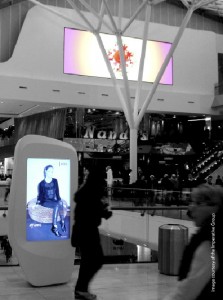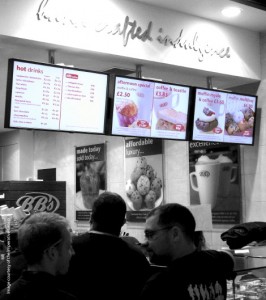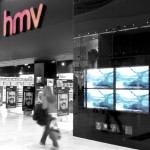Designing Digital Signage For The Audience: An Introduction
Whether you are developing a digital signage network for a client or on your own behalf, there really is only one person that takes precedence above all others and that of course is the person you want to engage, the viewer.
For several years the term bandied around was ‘content is king’; today, it’s been proven time and time again that in fact, ‘relevance is king’ and that without relevance, people (viewers) will see little value in any form of communication presented to them and will turn the page, flip the channel or in the case of digital signage, simply look away.
This article was originally published by AV magazine last week and is also available as a PDF on the
Imperative Group website as a PDF download – it was written by Chris Heap, Managing Director of the Imperative Group in association with Unicol and is republished here with kind permission
In order to ensure the best chance of success there are five fundamental points worth considering before engaging in the process of developing a digital signage network which relate to designing for the viewer:
- Understanding your audience.
- The viewing environment.
- Designing relevant, timely and appropriate content.
- Making it easy for viewers to view.
- Delivering a measurable return (for the viewer).
Let’s take a look at each one of those in a little more detail…
- Understanding your audience
 Research who shops or visits a particular store or venue, when and how often.
Research who shops or visits a particular store or venue, when and how often.Does the type of audience change throughout the day, across a week and how frequently do they visit?
Use your clients customer data if you can, to build up a profile of who your viewers are likely to be.
These profiles will inform what type of content is required at what times or in which parts of the venue enabling you and/or your client to be precise in targeting viewers with specific, relevant messages.
- The viewing environment
It is imperative you conduct an audit of the physical environment in relation to how it influences the manner in which people move through the physical space. This has a direct bearing on any potential design of the network (screens and screen placement) and the content (form and function). Ask simple questions such as whether the venue lends itself to different types of zones to cater for different audience habits. For example, there maybe areas within a venue that enables a viewer to watch a screen for a longer period of time (i.e. in a queue or a waiting area) than perhaps the entry or exit to a venue. There is a direct relationship between the screen and the viewer in any physical space that relates to ability to see versus proximity (and clarity).
- Designing relevant, timely and appropriate content
 Knowing who your viewers will be, what their interests & needs are and how often they may watch your network will inform the approach you or your client takes regarding what you are to present to the viewer by way of content.
Knowing who your viewers will be, what their interests & needs are and how often they may watch your network will inform the approach you or your client takes regarding what you are to present to the viewer by way of content.The flexible, dynamic nature of digital signage means that unlike posters and other venue-based communications, digital signage can be highly reactive to business needs or change according to the audience which is why time is an additional and valuable component to the marketing opportunity.
For example, If you are promoting retail products and services, can you use the screen network to feature particular offers based on the time of day, the day of the week or the season which makes the promotion relevant to the viewer, i.e. if it’s raining outside, push umbrellas. If it’s warm and sunny, push ice cream and sunglasses.
Taking the concept of time one stage further, if you were on your lunch-break and saw an offer on a screen in a store or in a window that said “buy me within the next five minutes and save 25%”, would you?
Time can offer significant viewer value and be used as a significant call to action.
The network should always provide helpful and useful information to the viewer to assist them in making better decisions which the network can do by offering advice, hints and tips. Help viewers understand that your client is a subject matter expert.
Entertain viewers where and when it is appropriate to do so. Digital signage networks have a commercial role to play but just like commercial television; if it isn’t engaging viewers won’t view, so find ways to inject humour and fun but also know when to keep it serious.
Ensure that at all times what the viewer sees is correct and up to date information. There are significant commercial benefits to doing this but from a customer’s point of view, if it’s on the screen it must be available.
Match the frequency of the repetition of the content to that of the viewer visiting the store. If 90% of viewers visit the venue once a week, programme the content to refresh weekly to ensure viewers see fresh content each time they visit. Repetition is not what viewers want and certainly something staff certainly do not want so avoid this as best you can.
If you need to use audio, match its levels to the ambient noise in the environment but don’t compete with it. If a viewer can clearly hear audio, it is complementary and helps the viewer understand the visual message then there maybe a case for audio but just because you can it doesn’t necessarily follow that you should. Treat audio with care.
- Making it easy for viewers to view
For a digital signage business to work at its most basic level, as many viewers as possible must be able to see both the screens and the content on those screens without making any effort whatsoever. The more effort that’s required on behalf of the viewer will mean the harder your network has to try to engage them and the more likely you will lose viewers, they’re not obliged to look at your screens after all. If only 50% of your potential viewers are able to see the screen at a given point, you have already reduced the commercial opportunity of that screen by half. The best outcome for any physical deployment is therefore to ensure that all screens and their content can be clearly seen without hindrance 100% of the time, specifically:
100% direct line of sight from maximum to minimum viewing distance.
100% at eye-level (level relative to distance; does not involve ‘head turning’).
High clarity of screen image (no pixilation, no reflection).
Correct colour settings (e.g. to enable a ‘true-life’ presentation).
Consider choosing a screen that offers the right level of image quality for its use. Screens closer to the shoppers’ field of vision may require higher quality screens than those further away. Image quality is relative to the viewing opportunity and the intrinsic limitation of human eyesight (do you really need an HD screen if viewers are 20m+ away from it?).
However, HD maybe appropriate to show suitably high quality content if the quality is part of the overall proposition e.g. selling high definition televisions/monitors, so choose the format most appropriate to the needs of the viewer or the customer.
- Delivering a measurable return (for the viewer)
 Viewers are phenomenally media savvy. They are active creators and users of digital communication and trade digitally every day (they create websites, they blog, they text, they email, they use PVRs, they create their own DVDs) and consequently the growing trend is for the audience to be more critical of what is presented to them.
Viewers are phenomenally media savvy. They are active creators and users of digital communication and trade digitally every day (they create websites, they blog, they text, they email, they use PVRs, they create their own DVDs) and consequently the growing trend is for the audience to be more critical of what is presented to them.There are many different ways networks measure commercial return, be that increasing viewer spend, increasing the time viewers spend in the venue, facilitating repeat visits or engaging enough viewers to attract advertising spend to name a few. This is all of course pointless if the network does not provide tangible qualitative reasons for the viewer to view, namely: –
“Don’t make it hard for me to watch you”
“When I do watch you, show me something relevant to me”
“Save me money”
“Save me time, don’t waste my time”
“Help me make better decisions”
“Tell me something new, innovative and interesting”
“Give me ideas”
Build your network to cater for these needs and you are significantly likely to create viewer value which in turn will generate all of the positive numbers required to validate almost all business cases relating to the deployment of digital signage networks.
Images courtesy of the Imperative Group.

June 30th, 2009 at 14:44 @655
Chris,
Interesting article the balancing act between making money i.e. advertising and entertaining your audience, i.e. viewers, infotainment is the key ingredient for why we watch and for how long. Without “infotainment” DOOH is nothing more than a zombie network delivering to a zombie audience by default they will watch.
Best regards,
JW Jr.